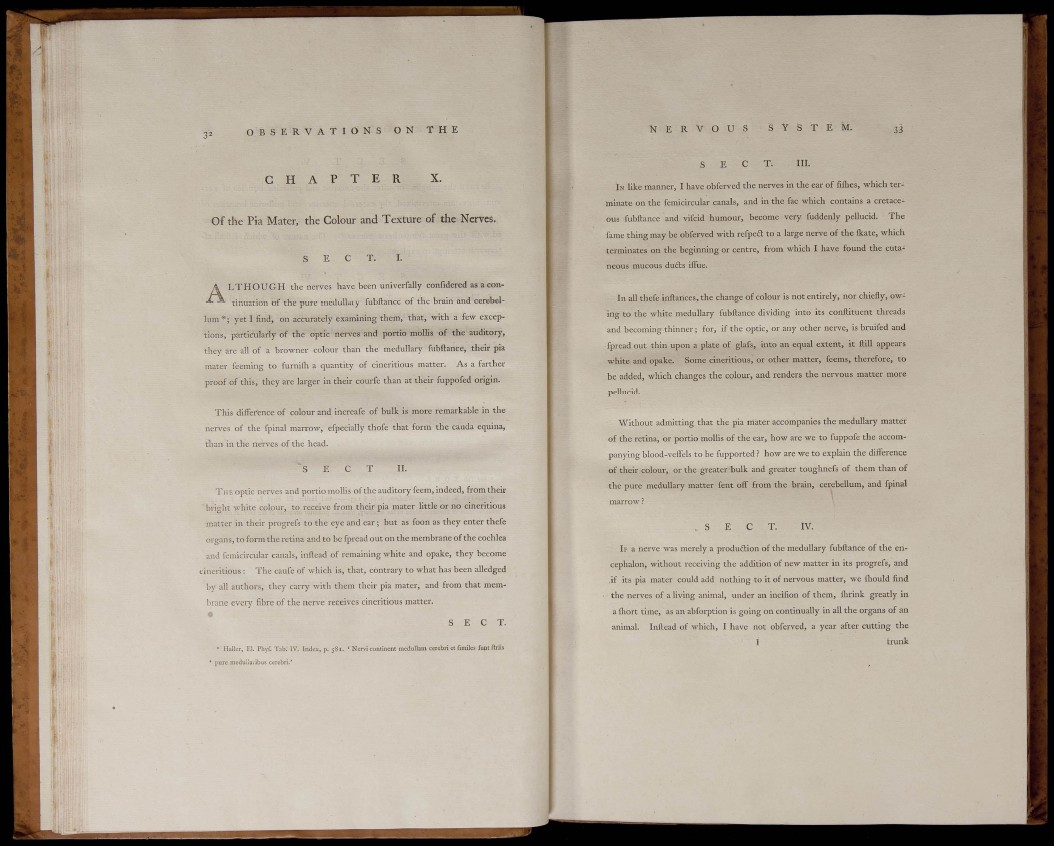
3» O B S E R V A T I O N S ON THE
C H A P T E R X.
Of the Pia Mater, the Colour and Texture of the Nerves.
S E C T . I.
A LTHOUGH the nerves have been univerfally confidered as a con-
^ tinuation of the pure medullary fubftance of the brain and cerebellum*;
yet I find, on accurately examining them, that, with a few exceptions,
particularly of the optic nerves and portio mollis of the auditory,
they are all of a browner colour than the medullary fubftance, their pia
mater fceming to furnilli a quantity of cineritious matter. As a farther
proof of this, they are larger in their courfe than at their fuppofed origin.
This difference of colour and incrcafe of bulk is more remarkable in the
nerves of the fpinal marrow, efpecially thofe that form the Cauda equina,
than in the nerves of the head.
' S E C T II.
THE optic nerves and portio mollis of the auditory feem, indeed, from their
bright white colour, to reccivc from their pia mater little or no cineritious
jnatter in their progrefs to the eye and ear; but as foon as they enter thefe
organs, to form the retina and to be fpread out on the membrane of the cochlea
and fcmicircular canals, inftead of remaining white and opake, they become
cineritious : The caufe of which is, that, contrary to what has been alledged
by all authors, they cany with them their pia mater, and from that membrane
eveiy fibre of the nerve receives cineritious matter.
S E C T .
• Haller, El. Phyf. Tab. IV. Index, p. «
' pure medullaiibus cerebri.'
' Nervi continent medullam cerebri et fimiles funt ftriis
N E R V O U S S Y S T E M . 33
T. III.
IN like manner, I have obferved the nerves in the ear of filhes, which terminate
on the femicircular canals, and in the fac which contains a cretaceous
fubftance and vifcid humour, become very fuddenly pellucid. The
fame thing may be obferved with refpedl to a large nerve of the fkate, which
terminates on the beginning or centre, from which I have found the cutaneous
raucous dudls iiTue.
In all thefe inftances, the change of colour is not entirely, nor chiefly, owing
to the white medullary fubftance dividing into its conftituent threads
and becoming thinner; for, if the optic, or any other nerve, is bruifed and
fpread out thin upon a plate of glafs, into an equal extent, it ftill appears
white and opake. Some cineritious, or other matter, feems, therefore, to
be added, which changes the colour, and renders the nervous matter more
pellucid.
Without admitting that the pia mater accompanies the medullary matter
of the retina, or portio mollis of the ear, how are we to fuppofe the accompanying
blood-vclTels to be fupported? how are we to explain the difference
of their colour, or the greater bulk and greater toughnefs of them than of
the pure medullary matter fent off from the brain, cerebellum, and fpinal
T. I V .
IF a nerve was merely a produftion of the medullary fubftance of the encephalon,
without receiving the addition of new matter in its progrefs, and
,if its pia mater could add nothing to it of nervous matter, we fliould find
the nerves of a living animal, under an incifion of them, fiirink greatly in
a iliort time, as an abforption is going on continually in aU the organs of an
animal. Inftead of which, I have not obferved, a year after cutting the
I trunk